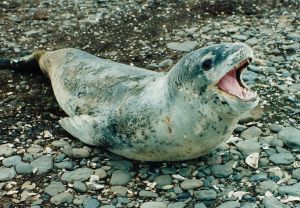Difference between revisions of "Marine mammal" - New World Encyclopedia
Rick Swarts (talk | contribs) |
Rick Swarts (talk | contribs) |
||
| Line 5: | Line 5: | ||
[[Image:Ursus maritimus 4 1996-08-04.jpg|thumb|A [[Polar bear]] (''Ursus maritimus''), a member of family [[Ursidae]]]] | [[Image:Ursus maritimus 4 1996-08-04.jpg|thumb|A [[Polar bear]] (''Ursus maritimus''), a member of family [[Ursidae]]]] | ||
[[Image:Sea lion family.JPG|right|thumb|[[California sea lion]]s, members of the family [[Otariidae]].]] | [[Image:Sea lion family.JPG|right|thumb|[[California sea lion]]s, members of the family [[Otariidae]].]] | ||
| + | '''Marine mammal''' is any of a diverse group of aquatic or semi-aquatic [[mammal]]s that are primarily [[ocean]]-dwelling and depend on the ocean for food, although some spend considerable time on land. There are four main groups of marine mammals: [[cetaceans]] ([[whale|whales]], [[dolphin|dolphins]], and [[porpoise|porpoises]]), [[sirenians]] ([[manatee|manatees]] and [[dugong]]), [[pinnipeds]] ([[true seals]], [[eared seals]], and [[walrus]]), and several [[otters]] (the [[sea otter]] and [[marine otter]]). The cetaceans and sirenians are completely aquatic, however, and the sea otters can mate and raise their young entirely at sea, while the pinnipeds spend considerable time on land, including giving birth and raising their young. | ||
| − | + | Some also include the [[polar bear]] with the marine mammals although they are a land mammal because they spend many months of the year on the frozen sea, hunting from sea ice. | |
| + | |||
| + | |||
| + | As it can hunt consistently only from sea ice, the polar bear spends much of the year on the frozen sea, although most polar bears are born on land. | ||
| + | |||
| + | The polar bear is often regarded as a [[marine mammal]] because it spends many months of the year at sea.<ref name="stirling1988intro">{{cite book|last=Stirling |first= Ian |year=1988 |title= Polar Bears |location= Ann Arbor |authorlink=Ian Stirling |publisher= University of Michigan Press |isbn= 0-472-10100-5 |chapter= Introduction}}</ref> Its preferred habitat is the annual [[sea ice]] covering the waters over the [[continental shelf]] and the Arctic inter-island [[archipelago]]s. These areas, known as the "Arctic ring of life", have relatively high [[biological productivity]] in comparison to the deep waters of the high Arctic.<ref name=derocher2004/><ref name=distribution/> The polar bear tends to frequent areas where sea ice meets water, such as [[polynya]]s and leads (temporary stretches of open water in Arctic ice), to hunt the seals that make up most of its diet.<ref>{{Citation | last1=Stirling | first1=Ian | date=January 1997 | title=The importance of polynyas, ice edges, and leads to marine mammals and birds | periodical=Journal of Marine Systems | publisher=Elsevier | volume=10 | issue=1-4 | pages=pp. 9–21 | doi=10.1016/S0924-7963(96)00054-1 | journal=Journal of Marine Systems}}.</ref> Polar bears are therefore found primarily along the perimeter of the [[Polar ice packs|polar ice pack]], rather than in the [[North Polar Basin|Polar Basin]] close to the [[North Pole]] where the den | ||
| + | |||
| + | |||
| + | The [[polar bear]] is also usually grouped with the marine mammals. | ||
| + | |||
| + | diverse group of roughly 120 species of [[mammal]] | ||
==Overview== | ==Overview== | ||
| − | :They are one of four groups of marine mammals, the others being [[cetacean]]s ([[whale]]s, [[dolphin]]s, and [[porpoise]]s), [[sirenian]]s ([[manatee]]s and [[dugong]]s), and [[sea otter]]s | + | :They are one of four groups of marine mammals, the others being [[cetacean]]s ([[whale]]s, [[dolphin]]s, and [[porpoise]]s), [[sirenian]]s ([[manatee]]s and [[dugong]]s), and [[sea otter]]s. |
* Riedman, M. 1990. [http://polarmet.mps.ohio-state.edu/ASPIRE_99/seals/science/evxt.htm Evolution, Classification, and Distribution of Pinnipeds.] In ''Pinnipeds: Seals, Sea Lions, and Walruses,'' 50–83. Berkeley: University of California Press. Retrieved June 15, 2007. | * Riedman, M. 1990. [http://polarmet.mps.ohio-state.edu/ASPIRE_99/seals/science/evxt.htm Evolution, Classification, and Distribution of Pinnipeds.] In ''Pinnipeds: Seals, Sea Lions, and Walruses,'' 50–83. Berkeley: University of California Press. Retrieved June 15, 2007. | ||
Revision as of 22:28, 26 October 2008
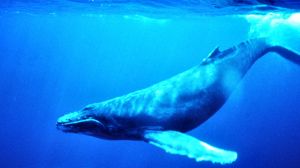
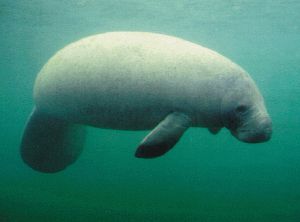
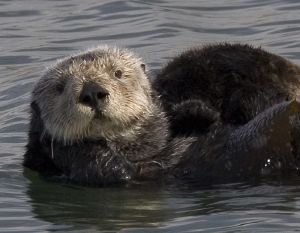
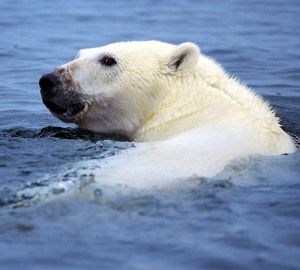
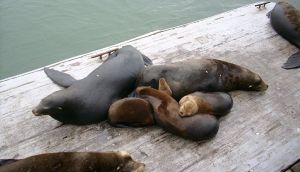
Marine mammal is any of a diverse group of aquatic or semi-aquatic mammals that are primarily ocean-dwelling and depend on the ocean for food, although some spend considerable time on land. There are four main groups of marine mammals: cetaceans (whales, dolphins, and porpoises), sirenians (manatees and dugong), pinnipeds (true seals, eared seals, and walrus), and several otters (the sea otter and marine otter). The cetaceans and sirenians are completely aquatic, however, and the sea otters can mate and raise their young entirely at sea, while the pinnipeds spend considerable time on land, including giving birth and raising their young.
Some also include the polar bear with the marine mammals although they are a land mammal because they spend many months of the year on the frozen sea, hunting from sea ice.
As it can hunt consistently only from sea ice, the polar bear spends much of the year on the frozen sea, although most polar bears are born on land.
The polar bear is often regarded as a marine mammal because it spends many months of the year at sea.[1] Its preferred habitat is the annual sea ice covering the waters over the continental shelf and the Arctic inter-island archipelagos. These areas, known as the "Arctic ring of life", have relatively high biological productivity in comparison to the deep waters of the high Arctic.[2][3] The polar bear tends to frequent areas where sea ice meets water, such as polynyas and leads (temporary stretches of open water in Arctic ice), to hunt the seals that make up most of its diet.[4] Polar bears are therefore found primarily along the perimeter of the polar ice pack, rather than in the Polar Basin close to the North Pole where the den
The polar bear is also usually grouped with the marine mammals.
diverse group of roughly 120 species of mammal
Overview
- They are one of four groups of marine mammals, the others being cetaceans (whales, dolphins, and porpoises), sirenians (manatees and dugongs), and sea otters.
- Riedman, M. 1990. Evolution, Classification, and Distribution of Pinnipeds. In Pinnipeds: Seals, Sea Lions, and Walruses, 50–83. Berkeley: University of California Press. Retrieved June 15, 2007.
- Mammals are the class (Mammalia) of vertebrate animals characterized by the presence of hair and mammary glands, which in females produce milk for the nourishment of young. As mammals, cetaceans have characteristics that are common to all mammals: They are warm-blooded, breathe in air utilizing lungs, bear their young alive and suckle them on their own milk, and have hair.
- Whales have very limited hair in isolated areas, thus reducing drag in the water. Instead, they maintain internal temperatures with a thick layer of blubber (vascularized fat).
Marine mammals evolved from land dwelling ancestors and share several adaptive features for life at sea such as generally large size, hydrodynamic body shapes, modified appendages and various thermoregulatory adaptations. Different species are, however, adapted to marine life to varying degrees. The most fully adapted are the cetaceans and the sirenians, whose entire life cycle takes place under water, whereas the other groups spend at least some time on land.
Despite the fact that marine mammals are highly recognizable charismatic megafauna, many populations are vulnerable or endangered due to a history of commercial exploitation for blubber, meat, ivory and fur. Most species are currently protected from commercial exploitation.
Groups
There are some 120 extant species of marine mammals, generally sub-divided into the five groups bold-faced below.[5]
- Order Sirenia: Sirenians
- family Trichechidae: manatees (3 species)
- family Dugongidae: dugong (1 species)
- Order Cetacea: Cetaceans
- Suborder Mysticeti: Baleen whales (14 or 15 species)
- Suborder Odontoceti: Toothed whales (around 73 species)
- Order Carnivora,
- superfamily Pinnipedia
- family Phocidae: true seals (around 20 species)
- family Otariidae: eared seals (around 16 species)
- family Odobenidae: walrus (1 species)
- family Mustelidae
- sea otter (Enhydra lutris)
- marine otter (Lontra felina)
- family Ursidae
- polar bear (Ursus maritimus)
- superfamily Pinnipedia
The sirenians and cetaceans are thought to be descendent from an ungulate ancestor, while the pinnipeds, otters and polar bear are descended from a caniform ancestor. The morphological similarities between these diverse groups are a result of convergent and parallel evolution.
Adaptations
Since mammals originally evolved on land, their spines are optimized for running, allowing for up-and-down but only little sideways motion. Therefore, marine mammals typically swim by moving their spine up and down. By contrast, fish normally swim by moving their spine sideways. For this reason, fish mostly have vertical caudal (tail) fins, while marine mammals have horizontal caudal fins.
Some of the primary differences between marine mammals and other marine life are:
- Marine mammals breathe air, while most other marine animals extract oxygen from water.
- Marine mammals have hair. Cetaceans have little or no hair, usually a very few bristles retained around the head or mouth. All members of the Carnivora have a coat of fur or hair, but it is far thicker and more important for thermoregulation in sea otters and polar bears than in seals or sea lions. Thick layers of fur contribute to drag while swimming, and slow down a swimming mammal, giving it a disadvantage in speed.
- Marine mammals have thick layers of blubber used to insulate their bodies and prevent heat loss. Sea otters and polar bears are exceptions, relying more on fur and behavior to stave off hypothermia.
- Marine mammals give birth. Most marine mammals give birth to one calf or pup at a time.
- Marine mammals feed off milk as young. Maternal care is extremely important to the survival of offspring that need to develop a thick insulating layer of blubber. The milk from the mammary glands of marine mammals often exceeds 40-50% fat content to support the development of blubber in the young.
- Marine mammals maintain a high internal body temperature. Unlike most other marine life, marine mammals carefully maintain a core temperature much higher than their environment. Blubber, thick coats of fur, bubbles of air between skin and water, countercurrent exchange, and behaviors such as hauling out, are all adaptations that aid marine mammals in retention of body heat.
The polar bear spends a large portion of its time in a marine environment, albeit a frozen one. When it does swim in the open sea it is extremely proficient and has been shown to cover 74 km in a day. For these reasons, some scientists regard it as a marine mammal.
Research
Considerable research has been conducted on the incidence of diseases that afflict marine mammals in the marine environment. This work has addressed leptospirosis, phocine herpesvirus, neurological diseases, toxicology[6] and other pathologies affecting marine mammals. Entire research organizations have developed such as the Marine Mammal Center to focus upon the rehabilitation and research functions of marine mammals.
ReferencesISBN links support NWE through referral fees
- ↑ Stirling, Ian (1988). "Introduction", Polar Bears. Ann Arbor: University of Michigan Press. ISBN 0-472-10100-5.
- ↑ Cite error: Invalid
<ref>tag; no text was provided for refs namedderocher2004 - ↑ Cite error: Invalid
<ref>tag; no text was provided for refs nameddistribution - ↑ Stirling, Ian (January 1997), "The importance of polynyas, ice edges, and leads to marine mammals and birds", Journal of Marine Systems 10 (1-4): pp. 9–21, Elsevier, DOI:10.1016/S0924-7963(96)00054-1 .
- ↑ Hoelzel, A. R. (Ed.) 2002. Marine mammal biology: an evolutionary approach. Oxford: Blackwell Publishing. ISBN 0632 05232 5
- ↑ Lavery, TJ, Butterfield, N, Kemper, CM, Reid, RJ, Sanderson, K. 2008. Metals and selenium in the liver and bone of three dolphin species from South Australia, 1988 - 2004. Science of the Total Environment, 390: 77 - 86.
See also
- Institute for Marine Mammal Studies
External links
- Read Congressional Research Service (CRS) Reports regarding Marine mammals
- A 2005 Report by the National Academy of Sciences entitled Marine Mammal Populations and Ocean Noise, is available for free online reading and research
- University of Washington Libraries Digital Collections — Freshwater and Marine Image Bank — Aquatic Mammals An ongoing digital collection of images related to marine and aquatic mammals.
- Marine Mammal Resource
Credits
New World Encyclopedia writers and editors rewrote and completed the Wikipedia article in accordance with New World Encyclopedia standards. This article abides by terms of the Creative Commons CC-by-sa 3.0 License (CC-by-sa), which may be used and disseminated with proper attribution. Credit is due under the terms of this license that can reference both the New World Encyclopedia contributors and the selfless volunteer contributors of the Wikimedia Foundation. To cite this article click here for a list of acceptable citing formats.The history of earlier contributions by wikipedians is accessible to researchers here:
The history of this article since it was imported to New World Encyclopedia:
Note: Some restrictions may apply to use of individual images which are separately licensed.
